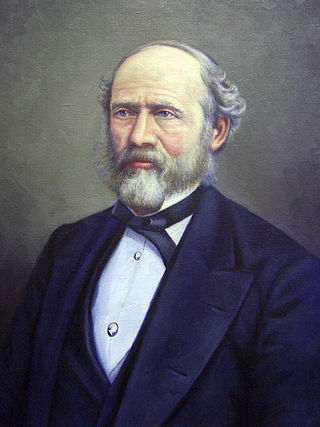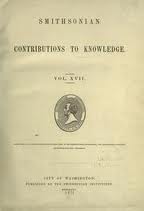
In anthropology, kinship is the web of social relationships that form an important part of the lives of all humans in all societies, although its exact meanings even within this discipline are often debated. Anthropologist Robin Fox says that the study of kinship is the study of what humans do with these basic facts of life – mating, gestation, parenthood, socialization, siblingship etc. Human society is unique, he argues, in that we are "working with the same raw material as exists in the animal world, but [we] can conceptualize and categorize it to serve social ends." These social ends include the socialization of children and the formation of basic economic, political and religious groups.

Lewis Henry Morgan was a pioneering American anthropologist and social theorist who worked as a railroad lawyer. He is best known for his work on kinship and social structure, his theories of social evolution, and his ethnography of the Iroquois. Interested in what holds societies together, he proposed the concept that the earliest human domestic institution was the matrilineal clan, not the patriarchal family.
Iroquois kinship is a kinship system named after the Haudenosaunee people, also known as the Iroquois, whose kinship system was the first one described to use this particular type of system. Identified by Lewis Henry Morgan in his 1871 work Systems of Consanguinity and Affinity of the Human Family, the Iroquois system is one of the six major kinship systems.
Eskimo kinship or Inuit kinship is a category of kinship used to define family organization in anthropology. Identified by Lewis Henry Morgan in his 1871 work Systems of Consanguinity and Affinity of the Human Family, the Eskimo system was one of six major kinship systems. The system of English-language kinship terms falls into the Eskimo type.
Hawaiian kinship, also referred to as the generational system, is a kinship terminology system used to define family within languages. Identified by Lewis H. Morgan in his 1871 work Systems of Consanguinity and Affinity of the Human Family, the Hawaiian system is one of the six major kinship systems.
Crow kinship is a kinship system used to define family. Identified by Lewis Henry Morgan in his 1871 work Systems of Consanguinity and Affinity of the Human Family, the Crow system is one of the six major kinship systems.
Omaha kinship is the system of terms and relationships used to define family in Omaha tribal culture. Identified by Lewis Henry Morgan in his 1871 work Systems of Consanguinity and Affinity of the Human Family, the Omaha system is one of the six major kinship systems which he identified internationally.
Sudanese kinship, also referred to as the descriptive system, is a kinship system used to define family. Identified by Lewis Henry Morgan in his 1871 work Systems of Consanguinity and Affinity of the Human Family, the Sudanese system is one of the six major kinship systems.
In discussing consanguineal kinship in anthropology, a parallel cousin or ortho-cousin is a cousin from a parent's same-sex sibling, while a cross-cousin is from a parent's opposite-sex sibling. Thus, a parallel cousin is the child of the father's brother or of the mother's sister, while a cross-cousin is the child of the mother's brother or of the father's sister. Where there are unilineal descent groups in a society, one's parallel cousins on one or both sides will belong to one's own descent group, while cross-cousins will not.

The Origin of the Family, Private Property and the State: in the Light of the Researches of Lewis H. Morgan is an 1884 philosophical treatise by Friedrich Engels. It is partially based on notes by Karl Marx to Lewis H. Morgan's book Ancient Society (1877). The book is an early historical materialist work and is regarded as one of the first major works on family economics.
Thomas Roger Trautmann is an American historian, cultural anthropologist, and Professor Emeritus of History and Anthropology at the University of Michigan. He is considered a leading expert on the Arthashastra, the ancient Hindu text on statecraft, economic policy, and military strategy, written in Sanskrit. Trautmann has mentored many students during his tenure at the University of Michigan. His studies focus on ancient India, the history of anthropology, and other related subjects. Trautmann's work in Indology has been credited with illuminating the underlying economic philosophy that governed ancient Indian kinship. He has also written book-length studies on both Dravidian and American Indian kinship. His most recent study concerns the use of the elephant in ancient India.
The term ethnotaxonomy refers either to that subdiscipline within ethnology which studies the taxonomic systems defined and used by individual ethnic groups, or to the operative individual taxonomy itself, which is the object of the ethnologist's immediate study.

Ancient Society is an 1877 book by the American anthropologist Lewis H. Morgan. Building on the data about kinship and social organization presented in his 1871 Systems of Consanguinity and Affinity of the Human Family, Morgan develops his theory of the three stages of human progress, i.e., from Savagery through Barbarism to Civilization. Contemporary European social theorists such as Karl Marx and Friedrich Engels were influenced by Morgan's work on social structure and material culture, as shown by Engels' The Origin of the Family, Private Property, and the State (1884).
Kinship terminology is the system used in languages to refer to the persons to whom an individual is related through kinship. Different societies classify kinship relations differently and therefore use different systems of kinship terminology; for example, some languages distinguish between consanguine and affinal uncles, whereas others have only one word to refer to both a father and his brothers. Kinship terminologies include the terms of address used in different languages or communities for different relatives and the terms of reference used to identify the relationship of these relatives to ego or to each other.
Floyd Glenn Lounsbury was an American linguist, anthropologist and Mayanist scholar and epigrapher, best known for his work on linguistic and cultural systems of a variety of North and South American languages. Equally important were his contributions to understanding the hieroglyphs, culture and history of the Maya civilization of pre-Columbian Mesoamerica.

Family is a group of people related either by consanguinity or affinity. It forms the basis for social order. The purpose of the family is to maintain the well-being of its members and of society. Ideally, families offer predictability, structure, and safety as members mature and learn to participate in the community. Historically, most human societies use family as the primary locus of attachment, nurturance, and socialization.
Ward Hunt Goodenough II was an American anthropologist, who has made contributions to kinship studies, linguistic anthropology, cross-cultural studies, and cognitive anthropology.
Systems theory in anthropology is an interdisciplinary, non-representative, non-referential, and non-Cartesian approach that brings together natural and social sciences to understand society in its complexity. The basic idea of a system theory in social science is to solve the classical problem of duality; mind-body, subject-object, form-content, signifier-signified, and structure-agency. System theory suggests that instead of creating closed categories into binaries (subject-object); the system should stay open so as to allow free flow of process and interactions. In this way the binaries are dissolved.
The origins of society — the evolutionary emergence of distinctively human social organization — is an important topic within evolutionary biology, anthropology, prehistory and palaeolithic archaeology. While little is known for certain, debates since Hobbes and Rousseau have returned again and again to the philosophical, moral and evolutionary questions posed.
Variations in the number of lexical categories across the languages is a notable idea in cultural anthropology. A former study on "color terms" explores such variations. Brent Berlin and Paul Kay (1969) argued that these qualitative and quantitative differences can be organized into a coherent hierarchy. As far as kinship terms are concerned, the variation is not found as an hierarchical organization, but as a result of conditions or constraints. That is to say, the number of kinship terms varies across the languages because of sociocultural conditions or constraints on the biological traits.






